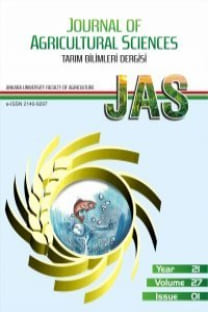Determination and Comparison of Bioactive Compounds in Different Parts of Glycyrrhiza Species
Determination and Comparison of Bioactive Compounds in Different Parts of Glycyrrhiza Species
___
- Alsaadi DHM., Raju A, Kusakari K, Karahan F, Sekeroglu N, Watanabe T (2020). Phytochemical Analysis and Habitat Suitability Mapping of Glycyrrhiza glabra L. Collected in the Hatay Region of Turkey. Molecules 25, 1–13. https://doi.org/10.3390/molecules25235529
- Bharathala S, Kotarkonda LK, Singh VP, Singh R, Sharma P (2021). In silico and experimental studies of bovine serum albumin-encapsulated carbenoxolone nanoparticles with reduced cytotoxicity. Colloids Surfaces B Biointerfaces 202, 111670. https://doi.org/10.1016/j.colsurfb.2021.111670
- Cheel J, Antwerpen PV, Tůmová L, Onofre G, Vokurková D, Zouaoui-Boudjeltia K, Vanhaeverbeek M, Nève J (2010). Free radical-scavenging, antioxidant and immunostimulating effects of a licorice infusion (Glycyrrhiza glabra L.). Food Chemistry 122, 508–517. https://doi.org/10.1016/j.foodchem.2010.02.060
- Cho HJ, Lim SS, Lee YS, Kim JS, Lee CH, Kwon DY, Park JHY (2010). Hexane/ethanol extract of Glycyrrhiza uralensis licorice exerts potent anti-inflammatory effects in murine macrophages and in mouse skin. Food Chemistry 121, 959–966. https://doi.org/10.1016/j.foodchem.2010.01.027
- Cinatl J, Morgenstern B, Bauer G, Chandra P, Rabenau H, Doerr HW (2003). Glycyrrhizin, an active component of liquorice roots, and replication of SARS-associated coronavirus. Lancet 361, 2045–2046. https://doi.org/10.1016/S0140-6736(03)13615-X
- Csuk R, Schwarz S, Kluge R, Ströhl D (2010). Synthesis and biological activity of some antitumor active derivatives from glycyrrhetinic acid. European Journal of Medicinal Chemistry 45, 5718–5723. https://doi.org/10.1016/j.ejmech.2010.09.028
- Duran A, Martin E, Kucukoduk M (2012). Cytotaxonomical study in some taxa of the genus Glycyrrhiza L . ( Fabaceae ).
- Hosseinzadeh H, Nassiri-Asl M (2015). Pharmacological Effects of Glycyrrhiza spp. and Its Bioactive Constituents: Update and Review. Phytotherapy Research 29, 1868–1886. https://doi.org/10.1002/ptr.5487
- Jiang Z, Wang Y, Zheng Y, Yang J, Zhang L (2016). Ultra high performance liquid chromatography coupled with triple quadrupole mass spectrometry and chemometric analysis of licorice based on the simultaneous determination of saponins and flavonoids. Journal of Separation Science 39, 2928–2940. https://doi.org/10.1002/jssc.201600246
- Kim JK, Oh SM, Kwon HS, Oh YS, Lim SS, Shin HK (2006). Anti-inflammatory effect of roasted licorice extracts on lipopolysaccharide-induced inflammatory responses in murine macrophages. Biochemical and Biophysical Research Communications 345, 1215–1223. https://doi.org/10.1016/j.bbrc.2006.05.035
- Krausse R, Bielenberg J, Blaschek W, Ullmann U (2004). In vitro anti-Helicobacter pylori activity of Extractum liquiritiae, glycyrrhizin and its metabolites. Journal of Antimicrobial Chemotherapy 54, 243–246. https://doi.org/10.1093/jac/dkh287
- Li G, Nikolic D, Van Breemen RB (2016). Identification and Chemical Standardization of Licorice Raw Materials and Dietary Supplements Using UHPLC-MS/MS. Journal of Agricultural and Food Chemistry 64, 8062–8070. https://doi.org/10.1021/acs.jafc.6b02954
- Liao WC, Lin YH, Chang TM, Huang WY (2012). Identification of two licorice species, Glycyrrhiza uralensis and Glycyrrhiza glabra, based on separation and identification of their bioactive components. Food Chemistry 132, 2188–2193. https://doi.org/10.1016/j.foodchem.2011.12.051
- Maatooq GT, Marzouk AM, Gray AI, Rosazza JP (2010). Bioactive microbial metabolites from glycyrrhetinic acid. Phytochemistry 71, 262–270. https://doi.org/10.1016/j.phytochem.2009.09.014
- Messier C, Epifano F, Genovese S, Grenier D (2012). Licorice and its potential beneficial effects in common oro-dental diseases. Oral Disease 18, 32–39. https://doi.org/10.1111/j.1601-0825.2011.01842.x
- Montoro P, Maldini M, Russo M, Postorino S, Piacente S, Pizza C (2011). Metabolic profiling of roots of liquorice (Glycyrrhiza glabra) from different geographical areas by ESI/MS/MS and determination of major metabolites by LC-ESI/MS and LC-ESI/MS/MS. Journal of Pharmaceutical and Biomedical Analysis 54, 535–544. https://doi.org/10.1016/j.jpba.2010.10.004
- Özcan FŞ, Özcan N, Us AA, Sağdiç O (2020). Comparison of extraction methods optimised by RSM for extraction of some bioactives from liquorice samples. Turkish Journal of Agriculture and Forestry 44, 24–38. https://doi.org/10.3906/tar-1903-46
- Quintana SE, Hernández DM, Villanueva-Bermejo D, García-Risco MR, Fornari T (2020). Fractionation and precipitation of licorice (Glycyrrhiza glabra L.) phytochemicals by supercritical antisolvent (SAS) technique. Lwt 126, 109315. https://doi.org/10.1016/j.lwt.2020.109315
- Russo M, Serra D, Suraci F, Di Sanzo R, Fuda S, Postorino S (2014). The potential of e-nose aroma profiling for identifying the geographical origin of licorice (Glycyrrhiza glabra L.) roots. Food Chemistry 165, 467–474. https://doi.org/10.1016/j.foodchem.2014.05.142
- Sasaki H, Takei M, Kobayashi M, Pollard RB, Suzuki F (2002). Effect of glycyrrhizin, an active component of licorice roots, on HIV replication in cultures of peripheral blood mononuclear cells from HIV-seropositive patients. Pathobiology 70, 229–236. https://doi.org/10.1159/000069334
- Wang ZY, Nixon DW (2001). Licorice and cancer. Nutrition and Cancer 39, 1–11. https://doi.org/10.1207/S15327914nc391_1
- Yang R, Wang LQ, Yuan BC, Liu Y (2015). The Pharmacological Activities of Licorice. Planta Medica 81, 1654–1669. https://doi.org/10.1055/s-0035-1557893
- Zhang Q, Ye M (2009). Chemical analysis of the Chinese herbal medicine Gan-Cao (licorice). Journal of Chromatography A 1216, 1954–1969. https://doi.org/10.1016/j.chroma.2008.07.072
- Yayın Aralığı: 4
- Yayıncı: Ankara Üniversitesi Basımevi
Fatma YENİLMEZ, Nurten YILMAZ, Ayşen BULANCAK, Emine URUK, Mikail BAYLAN, Ladine BAYKAL ÇELİK, Hasan KUTLU
Cafer GENÇOĞLAN, Hayri ŞAHİN, Serpil GENÇOĞLAN
Osman Tolga ÖZEL, Recayi ÇİMAGİL, Selin ERTÜRK GÜRKAN, İsa COŞKUN, Mustafa TÜRE, İlyas KUTLU
The Combined Effects of Salinity and Drought on Young Almond Trees and Physiological Parameters
Cenk KÜÇÜKYUMUK, Donald SUAREZ
Isolation and Characterization of Rhizospheric Bacteria from Vuralia turcica Rhizospheric Soil
Cem ÇİFTÇİ, Dilek TEKDAL, Burçin ÇINGAY, Selim ÇETİNER
Development of AI Based Larvae Transfer Machine for Royal Jelly Production
Serhan MERMER, Melis YALÇIN, Leyla Didem KOZACI, Cafer TURGUT
